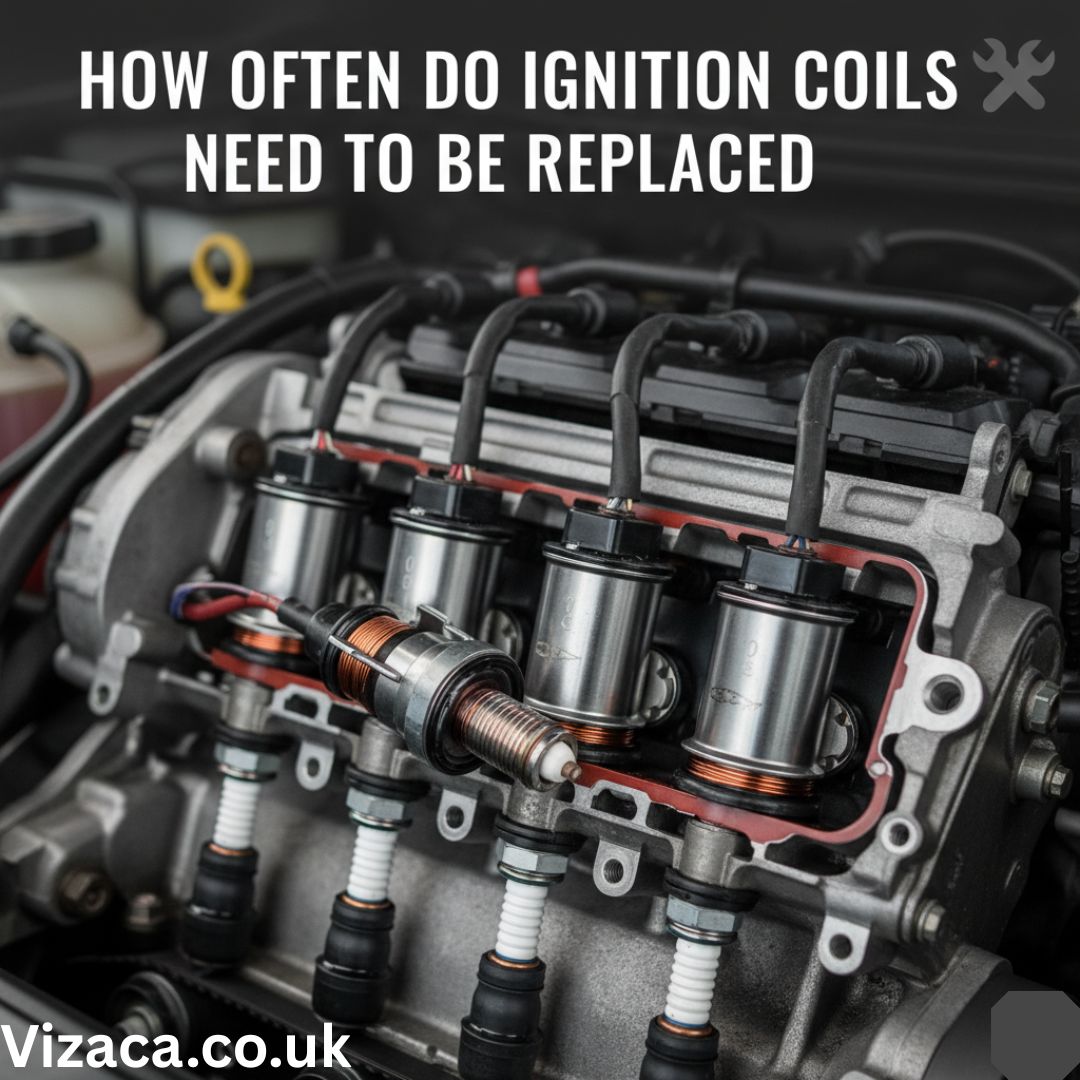Your vehicle’s ignition system plays a vital role in starting the engine and keeping it running smoothly. One of its most critical components is the ignition coil — a small but powerful device that transforms low-voltage electricity from the car’s battery into the high-voltage spark needed to ignite the air-fuel mixture inside the engine cylinders.
Like all car parts, ignition coils wear out over time. Knowing how often ignition coils need to be replaced can save you from unexpected breakdowns, rough engine performance, and costly repairs later on.
This comprehensive guide explains what ignition coils do, how long they last, the warning signs of failure, and maintenance tips to extend their lifespan.
What Is an Ignition Coil?
An ignition coil is an essential part of your car’s ignition system. It functions like a small transformer, converting the 12 volts from the battery into thousands of volts — sometimes up to 50,000 volts — to create a spark at the spark plug.
This spark ignites the air-fuel mixture in the engine’s combustion chamber, allowing the engine to start and run. Without properly functioning ignition coils, your engine may misfire, stall, or fail to start altogether.
In modern vehicles, each cylinder often has its own ignition coil, a design known as a coil-on-plug system. Older vehicles may have one central coil connected to all spark plugs via ignition wires.
How Long Do Ignition Coils Typically Last?
Under normal conditions, ignition coils are built to last a long time — generally 100,000 miles or more. However, several factors can shorten or extend their lifespan, including driving habits, maintenance frequency, and environmental conditions.
Here’s a general guideline based on vehicle type and usage:
| Vehicle Type | Expected Lifespan |
|---|---|
| Modern vehicles with coil-on-plug systems | 100,000–120,000 miles |
| Older vehicles with a single ignition coil | 60,000–80,000 miles |
| High-performance or turbocharged engines | 50,000–70,000 miles |
| Poorly maintained engines | 30,000–50,000 miles |
Even though ignition coils can last a long time, they aren’t immune to wear. Heat, vibration, and electrical stress eventually degrade them.
Factors That Affect Ignition Coil Lifespan
Several factors influence how often ignition coils need to be replaced. Understanding these helps you take better care of your vehicle.
1. Heat and Vibration
Ignition coils are constantly exposed to high engine temperatures and vibrations. Over time, this can cause internal wiring and insulation to deteriorate.
2. Poor Spark Plugs or Wires
Worn or damaged spark plugs force ignition coils to work harder, as they must generate more voltage to create a spark. This overwork accelerates coil wear.
3. Oil and Moisture Contamination
If oil leaks from valve covers or moisture enters the coil housing, it can short out the electrical system or corrode internal parts.
4. Electrical Issues
Voltage surges or faulty wiring can stress the ignition coil’s circuits, leading to early failure.
5. Driving Conditions
Stop-and-go city driving causes more frequent engine starts and stops, increasing coil activity and wear. In contrast, highway driving allows smoother operation and longer coil life.
Symptoms of a Bad Ignition Coil
Ignition coil failure doesn’t always happen suddenly. It often begins with subtle symptoms that worsen over time. Watch out for the following warning signs:
1. Engine Misfires
One of the most common symptoms of a bad ignition coil is engine misfiring. The engine may jerk, hesitate, or shake when accelerating.
2. Rough Idle
If your car vibrates or idles unevenly, a faulty coil might not be delivering consistent voltage to the spark plug.
3. Difficulty Starting
A weak ignition coil may not produce enough spark energy to ignite the fuel-air mixture, especially in cold weather.
4. Decreased Fuel Efficiency
If your engine doesn’t burn fuel efficiently, it can cause reduced gas mileage and poor performance.
5. Check Engine Light
Modern vehicles often display a “Check Engine” light when the ECU detects misfires or irregular voltage related to ignition coils.
6. Engine Stalling
In severe cases, a completely failed coil can cause the engine to stall unexpectedly while driving.
If you notice one or more of these signs, it’s best to inspect and possibly replace the ignition coils before further damage occurs.
How to Check the Condition of Your Ignition Coils
Testing ignition coils is a simple process for experienced DIYers or mechanics. Here’s how it’s generally done:
- Visual Inspection:
Look for visible cracks, corrosion, or carbon tracking on the coil housing. - Use an OBD-II Scanner:
Plug in a diagnostic scanner to check for misfire codes (like P0300–P0312). These codes can pinpoint which cylinder’s coil is failing. - Resistance Testing:
Using a multimeter, measure the resistance between the primary and secondary coil terminals. Compare the reading with manufacturer specifications. - Swap Test:
Swap a suspected faulty coil with one from another cylinder. If the misfire moves, the coil is the issue.
Regular inspection helps you replace only the bad coils instead of the entire set unnecessarily.
Should You Replace All Ignition Coils at Once?
This is a common question among car owners. The answer depends on your vehicle’s condition and mileage.
- If your car has high mileage (100,000 miles or more): Replacing all coils at once ensures consistent performance and prevents repeated labor costs.
- If only one coil fails early: You can replace just that single coil, especially if the others are still strong.
- If multiple coils show signs of wear: It’s best to change all coils and spark plugs together for long-term reliability.
Replacing them all at once may seem costly initially, but it saves you from multiple visits to the mechanic later.
How Often Should Ignition Coils Be Replaced?
Most mechanics recommend replacing ignition coils every 100,000 miles, or sooner if you notice performance issues.
However, mileage alone isn’t the only factor. Replace ignition coils when:
- The Check Engine light indicates misfire codes related to coils.
- You experience hard starts, rough idling, or power loss.
- The spark plugs are due for replacement, especially if they’ve worn unevenly.
- The car has been exposed to oil leaks or moisture damage near the ignition area.
As a general rule:
Replace ignition coils about every 100,000 miles or whenever performance symptoms appear.
Can You Drive With a Bad Ignition Coil?
Technically, yes — but you shouldn’t.
Driving with a bad ignition coil can lead to:
- Engine misfires that damage the catalytic converter.
- Poor fuel economy and reduced engine power.
- Hard starting and eventual engine failure.
Continuing to drive under these conditions can turn a simple $50 coil replacement into a $1,000+ repair.
Cost of Replacing Ignition Coils
The total cost depends on your vehicle type, labor rates, and whether you replace one or all coils.
| Vehicle Type | Parts Cost (per coil) | Labor Cost | Total Estimate |
|---|---|---|---|
| Economy cars | $40–$80 | $50–$100 | $90–$180 |
| Mid-range sedans | $60–$120 | $80–$150 | $140–$270 |
| Luxury or turbocharged cars | $100–$250 | $150–$300 | $250–$550 |
If you have basic mechanical skills, you can replace coils yourself using a socket wrench and your car’s repair manual — saving labor costs.
Tips to Extend the Life of Ignition Coils
You can significantly increase the life expectancy of ignition coils by following these maintenance practices:
- Replace spark plugs on schedule — worn plugs overwork coils.
- Keep oil leaks in check — oil contamination can short out coils.
- Avoid washing the engine bay with high-pressure water.
- Use high-quality fuel to minimize carbon buildup.
- Inspect wiring regularly for cracks or corrosion.
Proper maintenance of related components reduces stress on the ignition coil and prevents premature failure.
DIY Replacement Steps (For Reference)
If you decide to replace ignition coils yourself, here’s a brief overview of the process:
- Turn off the engine and disconnect the battery.
- Locate the ignition coils — they’re usually on top of the engine near the spark plugs.
- Remove the plastic engine cover if necessary.
- Disconnect the electrical connector from each coil.
- Unscrew and remove the coil from its housing.
- Insert the new ignition coil, tighten the bolt, and reconnect the connector.
- Repeat for each cylinder and test the engine after installation.
Always use coils that match your vehicle’s manufacturer specifications.
Final Thoughts
Understanding how often ignition coils need to be replaced is essential for keeping your vehicle reliable and efficient. These small components have a big impact on your engine’s health.
In most cases, ignition coils last around 100,000 miles, but factors like heat, moisture, and worn spark plugs can shorten their life. Regular inspections, timely spark plug changes, and addressing engine leaks help extend their lifespan.
If your car starts misfiring, idling roughly, or showing the “Check Engine” light, don’t ignore it. A quick inspection and replacement of the ignition coil can restore performance and prevent bigger problems down the road.
By following the advice in this guide, you can maintain a healthy ignition system and enjoy smoother, more efficient driving for years to come.










